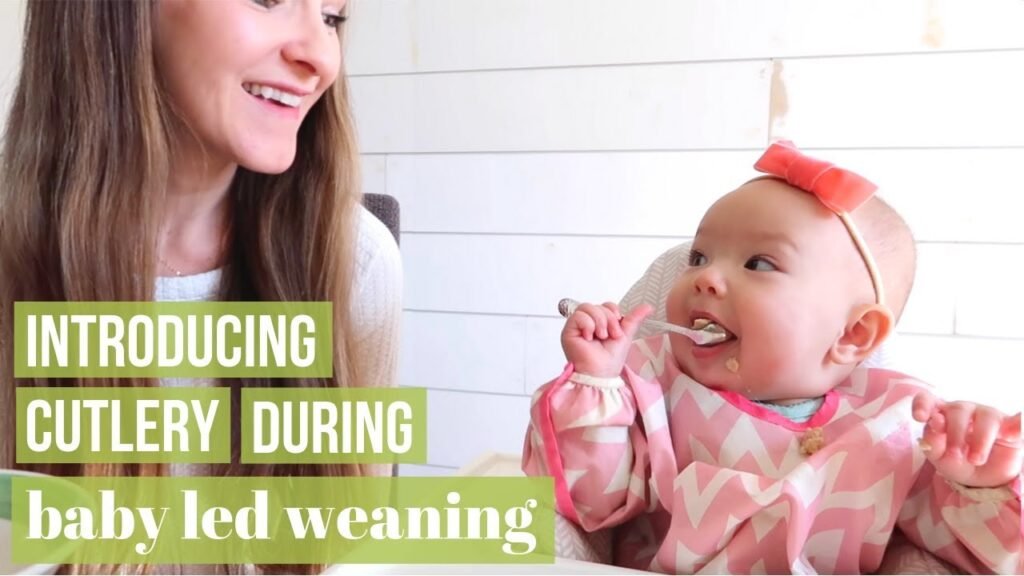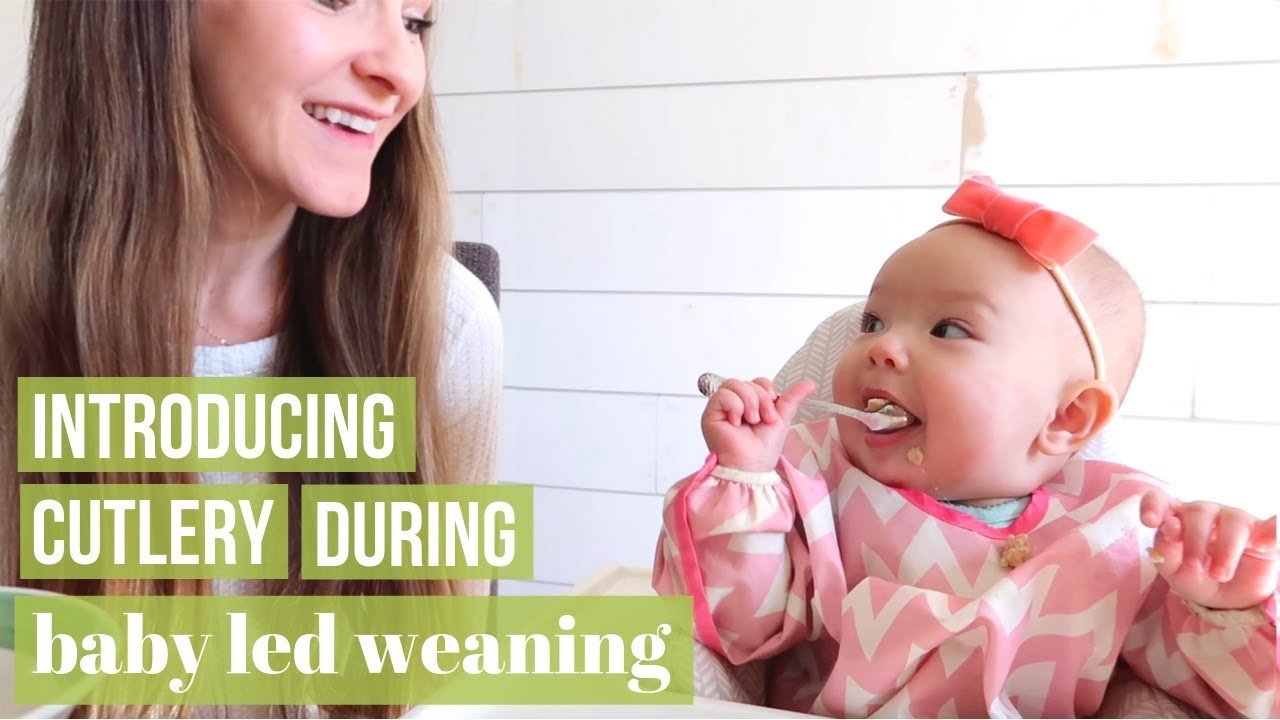Hey there! In this article, “Baby Led Weaning: Introducing a Spoon & Fork,” you’ll learn all about when and how to introduce cutlery to your little one. The video by Hapa Family provides tips on using metal cutlery for better grip and milestones in babies’ ability to independently use a spoon and fork. You’ll also see baby Mia’s first experience with a spoon and oatmeal, along with recommended cutlery sets for babies. So, get ready to see some adorable baby moments and pick up some valuable advice on mealtime behavior expectations!
Hi everyone! Meet Ashley, the mom of two lovely girls, Kylie and Mia. She’ll guide you through the process of introducing cutlery to your baby, emphasizing the importance of using metal over plastic and starting with easy-to-stab foods when introducing a fork. Ashley shares tips on when to introduce a spoon and fork, drawing from her experiences with her own daughters. Get ready for some messy but heartwarming moments as you witness Mia’s first encounter with a spoon and apple cinnamon oatmeal. So, get excited to embark on this exciting journey of helping your little one master the art of using cutlery!

When to Introduce Cutlery to Babies
When it comes to introducing cutlery to babies, timing is essential. Knowing when to introduce spoons and forks can significantly impact your baby’s mealtime experience and learning process. Additionally, it’s crucial to provide supervision during mealtime to ensure safety and support your baby’s progression in using cutlery effectively.
Timing for introducing spoons and forks
Introducing spoons and forks at the appropriate age is crucial for your baby’s development. It is generally recommended to introduce a spoon when your baby is around six months old. On the other hand, the introduction of forks is suggested around nine to ten months old when your baby starts developing their pincer grasp.
Importance of supervision during mealtime
Supervising your baby during mealtime is essential to prevent accidents and ensure they are using cutlery correctly. By closely monitoring their progress and providing guidance when needed, you can help them develop essential motor skills and mealtime etiquette.
Benefits of Using Metal Cutlery
Using metal cutlery offers numerous benefits for babies compared to plastic alternatives. Metal cutlery provides a better grip, durability, and longevity, making it an ideal choice for young learners.
Improvement in grip and motor skills
Metal cutlery offers a firmer grip, allowing babies to grasp utensils more effectively. This improved grip enhances their motor skills and coordination, enabling them to feed themselves with greater ease and confidence.
Durability and longevity compared to plastic
Metal cutlery is more durable and long-lasting compared to plastic utensils. The sturdiness of metal cutlery ensures that it can withstand the wear and tear of daily use, providing your baby with reliable tools for their mealtime needs.
Introducing Spoon and Fork
Introducing spoons and forks to your baby is an exciting milestone in their journey towards self-feeding. Understanding when and how to introduce these utensils can make the process smoother and more enjoyable for both you and your little one.
Spoon introduction around six months old
As your baby starts solids around six months old, introducing a spoon can help them explore different textures and flavors. Preloading the spoon with food and guiding them through the scooping motion can kickstart their self-feeding journey.
Fork introduction around nine to ten months old
When your baby begins developing their pincer grasp, around nine to ten months old, introducing a fork can enhance their fine motor skills. Starting with easy-to-stab foods and gradually progressing to more challenging textures can help them master the art of using a fork.
Baby’s First Experience with a Spoon
Witnessing your baby’s first experience with a spoon can be a heartwarming moment filled with curiosity and excitement. Let’s take a look at an example of baby Mia trying oatmeal with a spoon and observe her reactions during this significant milestone.
Example of baby Mia trying oatmeal with a spoon
At around seven months old, baby Mia is introduced to a spoon and oatmeal for the first time. This precious moment captures her initial attempts at self-feeding and showcases her adorable reactions and facial expressions as she navigates this new experience.
Reactions and facial expressions during the experience
From the anticipation of tasting oatmeal to the joy of successfully bringing the spoon to her mouth, baby Mia’s reactions during her first spoon-feeding experience are priceless. Despite some spillage and initial struggles, her determination and curiosity shine through as she explores the world of self-feeding.
Tips for Introducing Fork to Babies
Introducing a fork to your baby requires careful consideration and preparation to ensure a positive learning experience. Here are some helpful tips to guide you through the process of introducing a fork to your little one.
Starting with easy-to-stab foods like soft fruits
Begin by offering your baby easy-to-stab foods such as soft fruits or cooked vegetables. These items are ideal for practicing fork skills and building confidence in using this utensil effectively.
Gradual progression to harder foods as skills develop
As your baby becomes more proficient in using a fork, gradually introduce harder foods that require more precision and control. By progressing at their pace and providing continuous support, you can help them master the art of using a fork with ease.
Milestones in Independent Cutlery Use
Watching your baby transition from needing assistance with cutlery to independently feeding themselves is a significant milestone in their development. Let’s explore the stages of progress and improvement your baby may experience on their journey towards independent cutlery use.
Initial struggles and spills during early attempts
During the initial stages of learning to use cutlery, your baby may experience some struggles and spills as they navigate the process. These early attempts are essential for building coordination and mastering the necessary movements for self-feeding.
Gradual improvement in coordination and efficiency
With consistent practice and encouragement, your baby will gradually improve their coordination and efficiency in using cutlery. Over time, they will develop the skills needed to feed themselves independently, showcasing their growing confidence and dexterity.
Practice and Patience in Learning
Learning to use cutlery requires practice, patience, and positive reinforcement. By incorporating these elements into your baby’s mealtime routine, you can help them develop essential self-feeding habits and foster a love for exploring different foods.
Importance of consistent practice and positive reinforcement
Consistent practice is key to mastering the art of using cutlery. Encourage your baby to practice using spoons and forks regularly, praising their efforts and progress along the way. Positive reinforcement can boost their confidence and motivation to continue learning.
Encouraging self-feeding habits and exploration of different foods
Encouraging your baby to self-feed promotes independence and autonomy during mealtime. By offering a variety of foods and utensils, you can inspire them to explore new flavors and textures while honing their motor skills and fine motor abilities.
Recommended Cutlery Sets for Babies
Choosing the right cutlery set for your baby is essential for their comfort, safety, and learning experience. Opting for ergonomically designed spoons and forks that cater to small hands can make mealtime more enjoyable and engaging for your little one.
Ergonomically designed spoons and forks for small hands
Selecting cutlery sets with ergonomic designs tailored to small hands can facilitate your baby’s grip and control while eating. These specially crafted utensils provide comfort and stability, making it easier for your baby to master the art of using cutlery.
Safe and easy-to-clean materials for hygiene
Prioritizing safety and hygiene when choosing cutlery sets for babies is crucial. Opt for materials that are safe, durable, and easy to clean to ensure that your baby’s mealtime tools are always in top condition and free from harmful substances.
Mealtime Behavior Expectations
Setting mealtime behavior expectations is essential for promoting healthy eating habits and table manners from an early age. By establishing rules and routines, you can create a positive mealtime environment that encourages positive eating habits and fosters a sense of responsibility in your child.
Teaser for the upcoming video on setting mealtime rules
Stay tuned for our upcoming video where we will delve into setting mealtime rules and expectations for your baby. Discover practical tips and strategies for instilling healthy eating habits and demonstrating proper table manners during mealtime.
Promoting healthy eating habits and table manners from an early age
By promoting healthy eating habits and teaching proper table manners from an early age, you can instill lifelong skills and values in your child. Encouraging positive behaviors at mealtime creates a nurturing and respectful environment that supports your baby’s overall development and well-being.
In conclusion, introducing cutlery to babies is a meaningful and exciting process that contributes to their growth and development. By understanding the timing, benefits, and techniques involved in introducing spoons and forks, you can help your baby become proficient in self-feeding and mealtime etiquette. With patience, practice, and positivity, you can support your baby’s journey towards mastering the art of using cutlery and fostering healthy eating habits.

